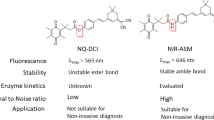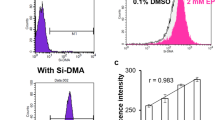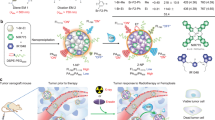Abstract
Lipids and their metabolites are easily oxidized in chain reactions initiated by lipid radicals, forming lipid peroxidation products that include the electrophiles 4-hydroxynonenal and malondialdehyde. These markers can bind cellular macromolecules, causing inflammation, apoptosis and other damage. Methods to detect and neutralize the initiating radicals would provide insights into disease mechanisms and new therapeutic approaches. We describe the first high-sensitivity, specific fluorescence probe for lipid radicals, 2,2,6-trimethyl-4-(4-nitrobenzo[1,2,5]oxadiazol-7-ylamino)-6-pentylpiperidine-1-oxyl (NBD-Pen). NBD-Pen directly detected lipid radicals in living cells by turn-on fluorescence. In a rat model of hepatic carcinoma induced by diethylnitrosamine (DEN), NBD-Pen detected lipid radical generation within 1 h of DEN administration. The lipid radical scavenging moiety of NBD-Pen decreased inflammation, apoptosis and oxidative stress markers at 24 h after DEN, and liver tumor development at 12 weeks. Thus, we have developed a novel fluorescence probe that provides imaging information about lipid radical generation and potential therapeutic benefits in vivo.
This is a preview of subscription content, access via your institution
Access options
Subscribe to this journal
Receive 12 print issues and online access
$259.00 per year
only $21.58 per issue
Buy this article
- Purchase on Springer Link
- Instant access to full article PDF
Prices may be subject to local taxes which are calculated during checkout





Similar content being viewed by others
References
Yin, H., Xu, L. & Porter, N.A. Free radical lipid peroxidation: mechanisms and analysis. Chem. Rev. 111, 5944–5972 (2011).
Niki, E. Biomarkers of lipid peroxidation in clinical material. Biochim. Biophys. Acta 1840, 809–817 (2014).
West, X.Z. et al. Oxidative stress induces angiogenesis by activating TLR2 with novel endogenous ligands. Nature 467, 972–976 (2010).
Rudolph, T.K. & Freeman, B.A. Transduction of redox signaling by electrophile-protein reactions. Sci. Signal. 2, re7 (2009).
Buettner, G.R. Spin trapping: ESR parameters of spin adducts. Free Radic. Biol. Med. 3, 259–303 (1987).
Bagryanskaya, E.G. & Marque, S.R. Scavenging of organic C-centered radicals by nitroxides. Chem. Rev. 114, 5011–5056 (2014).
Blinco, J.P., Fairfull-Smith, K.E., Morrow, B.J. & Bottle, S.E. Profluorescent nitroxides as sensitive probes of oxidative change and free radical reactions. Aust. J. Chem. 64, 373–389 (2011).
Jia, M., Tang, Y., Lam, Y.F., Green, S.A. & Blough, N.V. Prefluorescent nitroxide probe for the highly sensitive determination of peroxyl and other radical oxidants. Anal. Chem. 81, 8033–8040 (2009).
Mito, F. et al. Oxygen concentration dependence of lipid peroxidation and lipid-derived radical generation: application of profluorescent nitroxide switch. Free Radic. Res. 45, 1103–1110 (2011).
Abbas, K. et al. Detection of superoxide production in stimulated and unstimulated living cells using new cyclic nitrone spin traps. Free Radic. Biol. Med. 71, 281–290 (2014).
Bartsch, H., Hietanen, E. & Malaveille, C. Carcinogenic nitrosamines: free radical aspects of their action. Free Radic. Biol. Med. 7, 637–644 (1989).
Hebels, D.G., Briedé, J.J., Khampang, R., Kleinjans, J.C. & de Kok, T.M. Radical mechanisms in nitrosamine- and nitrosamide-induced whole-genome gene expression modulations in Caco-2 cells. Toxicol. Sci. 116, 194–205 (2010).
Yamada, K., Yamamiya, I. & Utsumi, H. In vivo detection of free radicals induced by diethylnitrosamine in rat liver tissue. Free Radic. Biol. Med. 40, 2040–2046 (2006).
Negre-Salvayre, A., Coatrieux, C., Ingueneau, C. & Salvayre, R. Advanced lipid peroxidation end products in oxidative damage to proteins. Potential role in diseases and therapeutic prospects for the inhibitors. Br. J. Pharmacol. 153, 6–20 (2008).
Farazi, P.A. & DePinho, R.A. Hepatocellular carcinoma pathogenesis: from genes to environment. Nat. Rev. Cancer 6, 674–687 (2006).
Naugler, W.E. et al. Gender disparity in liver cancer due to sex differences in MyD88-dependent IL-6 production. Science 317, 121–124 (2007).
Nakae, D. et al. Involvement of 8-hydroxyguanine formation in the initiation of rat liver carcinogenesis by low dose levels of N-nitrosodiethylamine. Cancer Res. 57, 1281–1287 (1997).
Sakurai, T., Maeda, S., Chang, L. & Karin, M. Loss of hepatic NF-kappa B activity enhances chemical hepatocarcinogenesis through sustained c-Jun N-terminal kinase 1 activation. Proc. Natl. Acad. Sci. USA 103, 10544–10551 (2006).
Hui, L., Zatloukal, K., Scheuch, H., Stepniak, E. & Wagner, E.F. Proliferation of human HCC cells and chemically induced mouse liver cancers requires JNK1-dependent p21 downregulation. J. Clin. Invest. 118, 3943–3953 (2008).
Uchida, K. et al. Activation of stress signaling pathways by the end product of lipid peroxidation. 4-hydroxy-2-nonenal is a potential inducer of intracellular peroxide production. J. Biol. Chem. 274, 2234–2242 (1999).
Parola, M. et al. HNE interacts directly with JNK isoforms in human hepatic stellate cells. J. Clin. Invest. 102, 1942–1950 (1998).
Bognár, B., Osz, E., Hideg, K. & Kalai, T. Synthesis of new double (spin and fluorescence) sensor reagents and labels. J. Heterocycl. Chem. 43, 81–86 (2006).
Lin, S. & Struve, W.S. Time-resolved fluorescence of nitrobenzoxadiazole-aminohexanoic acid: effect of intermolecular hydrogen-bonding on non-radiative decay. Photochem. Photobiol. 54, 361–365 (1991).
Yamasaki, T. et al. Structure-reactivity relationship of piperidine nitroxide: electrochemical, ESR and computational studies. J. Org. Chem. 76, 435–440 (2011).
Yamasaki, T. et al. Structural concept of nitroxide as a lipid peroxidation inhibitor. J. Org. Chem. 76, 4144–4148 (2011).
Blinco, J.P. et al. Experimental and theoretical studies of the redox potentials of cyclic nitroxides. J. Org. Chem. 73, 6763–6771 (2008).
Yamasaki, T., Matsuoka, Y., Mito, F., Yamato, M. & Yamada, K. Redox potential of nitroxides is an index to evaluate superoxide dismutase mimic activity. Asian J. Org. Chem. 2, 388–391 (2013).
Thaler, S. et al. Neuroprotective effects of Tempol acyl esters against retinal ganglion cell death in a rat partial optic nerve crush model. Acta Ophthalmol. 89, e555–e560 (2011).
Wagner, B.A., Buettner, G.R. & Burns, C.P. Free radical-mediated lipid peroxidation in cells: oxidizability is a function of cell lipid bis-allylic hydrogen content. Biochemistry 33, 4449–4453 (1994).
Krishna, M.C. et al. Do nitroxide antioxidants act as scavengers of O2−• or as SOD mimics? J. Biol. Chem. 271, 26026–26031 (1996).
Lee, J.S. et al. Application of comparative functional genomics to identify best-fit mouse models to study human cancer. Nat. Genet. 36, 1306–1311 (2004).
Maeda, S., Kamata, H., Luo, J.L., Leffert, H. & Karin, M. IKKβ couples hepatocyte death to cytokine-driven compensatory proliferation that promotes chemical hepatocarcinogenesis. Cell 121, 977–990 (2005).
Factor, V.M. et al. Vitamin E reduces chromosomal damage and inhibits hepatic tumor formation in a transgenic mouse model. Proc. Natl. Acad. Sci. USA 97, 2196–2201 (2000).
Park, E.J. et al. Dietary and genetic obesity promote liver inflammation and tumorigenesis by enhancing IL-6 and TNF expression. Cell 140, 197–208 (2010).
Blair, I.A. DNA adducts with lipid peroxidation products. J. Biol. Chem. 283, 15545–15549 (2008).
Marnett, L.J., Riggins, J.N. & West, J.D. Endogenous generation of reactive oxidants and electrophiles and their reactions with DNA and protein. J. Clin. Invest. 111, 583–593 (2003).
Pollack, M., Yang, I.Y., Kim, H.Y., Blair, I.A. & Moriya, M. Translesion DNA Synthesis across the heptanone--etheno-2′-deoxycytidine adduct in cells. Chem. Res. Toxicol. 19, 1074–1079 (2006).
Soresi, M. et al. Interleukin-6 and its soluble receptor in patients with liver cirrhosis and hepatocellular carcinoma. World J. Gastroenterol. 12, 2563–2568 (2006).
Nagata, H. et al. Inhibition of c-Jun NH2-terminal kinase switches Smad3 signaling from oncogenesis to tumor- suppression in rat hepatocellular carcinoma. Hepatology 49, 1944–1953 (2009).
Seki, E., Brenner, D.A. & Karin, M. A liver full of JNK: signaling in regulation of cell function and disease pathogenesis, and clinical approaches. Gastroenterology 143, 307–320 (2012).
Gorrini, C., Harris, I.S. & Mak, T.W. Modulation of oxidative stress as an anticancer strategy. Nat. Rev. Drug Discov. 12, 931–947 (2013).
Seglen, P.O. Preparation of isolated rat liver cells. Methods Cell Biol. 13, 29–83 (1976).
Bligh, E.G. & Dyer, W.J. A rapid method of total lipid extraction and purification. Can. J. Biochem. Physiol. 37, 911–917 (1959).
Acknowledgements
This work was supported in part by JST PRESTO, by JSPS KAKENHI grant number 24390011 and 24659020, by the Platform Project for Supporting in Drug Discovery and Life Science Research from AMED, Japan, by the Suzuken Memorial Foundation, Nagoya, Japan, and by the Suntory Foundation for Life Sciences, Kyoto, Japan. We appreciate the technical support provided by the Research Support Center, Graduate School of Medical Sciences, Kyushu University.
Author information
Authors and Affiliations
Contributions
K.Y. designed experiments and conceived and supervised the overall project. K.Y. also performed final data analysis and wrote the manuscript. F.M., Y.M., K.S. and Y.I. performed experiments and analyzed data for properties and mechanistic analysis of probes. S.I., A.F. and A.T. performed experiments and analyzed data for animal experiments. D.K. and M.E. performed experiments and analyzed data for cell experiments. M.A. performed experiments early in the project. T.Y. designed and performed chemical syntheses and wrote the synthetic methods for the manuscript. M.Y. designed experiments and performed final data analysis.
Corresponding author
Ethics declarations
Competing interests
The authors declare no competing financial interests.
Supplementary information
Supplementary Text and Figures
Supplementary Results, Supplementary Table 1 and Supplementary Figures 1–16. (PDF 19711 kb)
Supplementary Note
Synthetic procedures (PDF 190 kb)
Rights and permissions
About this article
Cite this article
Yamada, Ki., Mito, F., Matsuoka, Y. et al. Fluorescence probes to detect lipid-derived radicals. Nat Chem Biol 12, 608–613 (2016). https://doi.org/10.1038/nchembio.2105
Received:
Accepted:
Published:
Issue Date:
DOI: https://doi.org/10.1038/nchembio.2105



